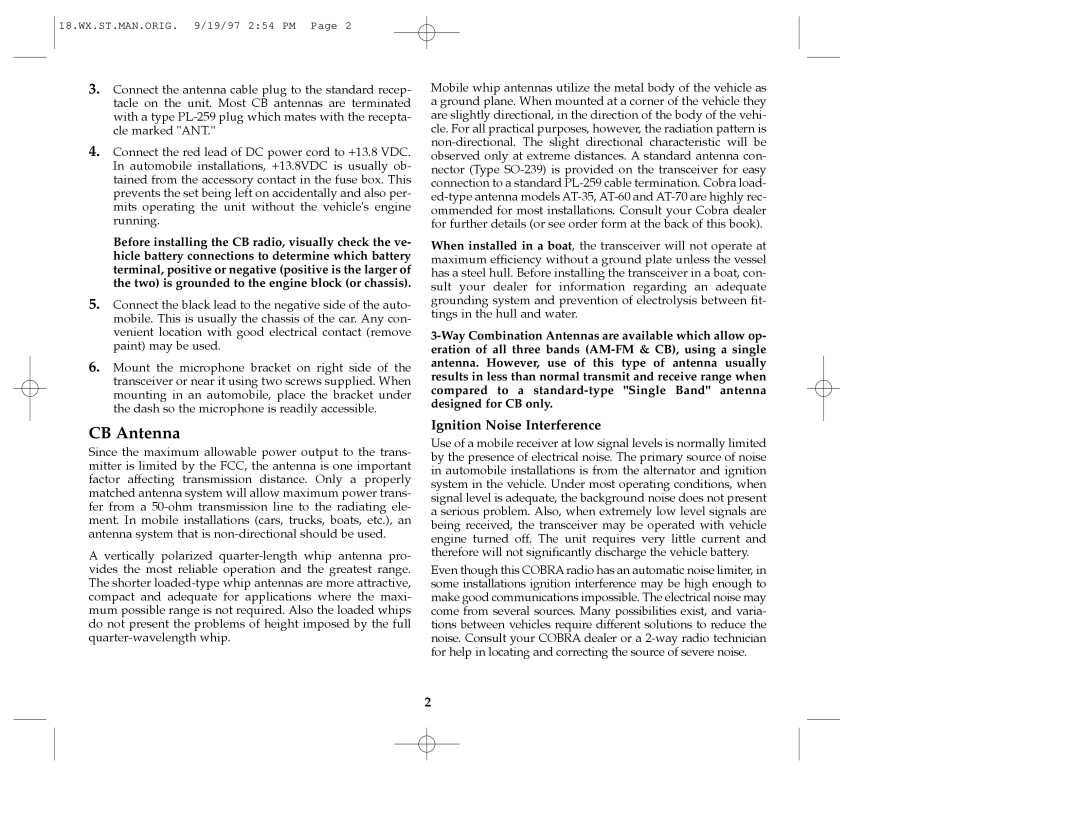
18.WX.ST.MAN.ORIG. 9/19/97 2:54 PM Page 2
3.Connect the antenna cable plug to the standard recep- tacle on the unit. Most CB antennas are terminated with a type
4.Connect the red lead of DC power cord to +13.8 VDC. In automobile installations, +13.8VDC is usually ob- tained from the accessory contact in the fuse box. This prevents the set being left on accidentally and also per- mits operating the unit without the vehicle's engine running.
Before installing the CB radio, visually check the ve- hicle battery connections to determine which battery terminal, positive or negative (positive is the larger of the two) is grounded to the engine block (or chassis).
5.Connect the black lead to the negative side of the auto- mobile. This is usually the chassis of the car. Any con- venient location with good electrical contact (remove paint) may be used.
6.Mount the microphone bracket on right side of the transceiver or near it using two screws supplied. When mounting in an automobile, place the bracket under the dash so the microphone is readily accessible.
CB Antenna
Since the maximum allowable power output to the trans- mitter is limited by the FCC, the antenna is one important factor affecting transmission distance. Only a properly matched antenna system will allow maximum power trans- fer from a
A vertically polarized
Mobile whip antennas utilize the metal body of the vehicle as a ground plane. When mounted at a corner of the vehicle they are slightly directional, in the direction of the body of the vehi- cle. For all practical purposes, however, the radiation pattern is
When installed in a boat, the transceiver will not operate at maximum efficiency without a ground plate unless the vessel has a steel hull. Before installing the transceiver in a boat, con- sult your dealer for information regarding an adequate grounding system and prevention of electrolysis between fit- tings in the hull and water.
Ignition Noise Interference
Use of a mobile receiver at low signal levels is normally limited by the presence of electrical noise. The primary source of noise in automobile installations is from the alternator and ignition system in the vehicle. Under most operating conditions, when signal level is adequate, the background noise does not present a serious problem. Also, when extremely low level signals are being received, the transceiver may be operated with vehicle engine turned off. The unit requires very little current and therefore will not significantly discharge the vehicle battery.
Even though this COBRA radio has an automatic noise limiter, in some installations ignition interference may be high enough to make good communications impossible. The electrical noise may come from several sources. Many possibilities exist, and varia- tions between vehicles require different solutions to reduce the noise. Consult your COBRA dealer or a
2
